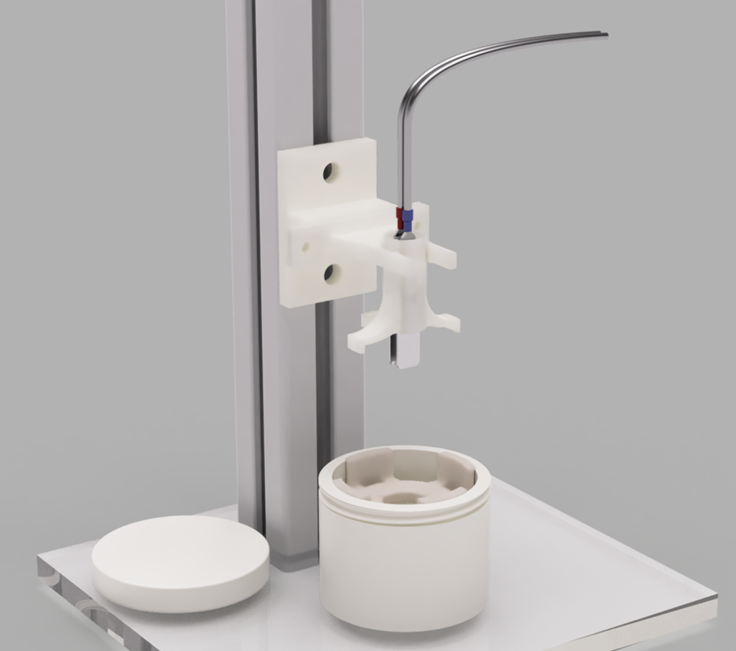NEWS
Neue Erkenntnisse für die Krebsforschung aus der Forschungsgruppe Immunoprofiling
Die Forschungsgruppe Immunoprofiling des Forschungscampus STIMULATE hat zwei bedeutende wissenschaftliche Studien veröffentlicht, die neue Erkenntnisse für die Krebsforschung liefern. Die Gruppe besteht aus einem interdisziplinären Team aus Klinik, Universität und Industrie. Erst durch die enge Zusammenarbeit, ermöglicht durch das vom Bundesministerium für Bildung und Forschung (BMBF) geförderte Format Forschungscampus, konnten diese wichtigen Ergebnisse erzielt werden.
In der ersten Studie untersuchte das Team die Rolle des Proteins CCL2 bei Patient:innen mit nicht-operablem Leberkrebs, die eine spezielle Form der Strahlentherapie erhielten. Sie fanden heraus, dass erhöhte CCL2-Werte mit einer verkürzten Überlebenszeit verbunden sind. Diese Entdeckung könnte künftig dazu beitragen, den Krankheitsverlauf besser vorherzusagen und die Behandlung individueller anzupassen. Die Studie ist mit dem Titel "CCL2 Predicts Survival in Patients with Inoperable Hepatocellular Carcinoma Undergoing Selective Internal Radiotherapy" in der renommierten Fachzeitschrift Cancers (IF 4,9) erschienen und kann hier eingesehen werden.
In der zweiten Studie entwickelte die Gruppe ein neuartiges 3D-Modell, um die minimal-invasive Therapie von Tumoren mittels elektroporativer Ablation zu untersuchen. Bei diesem Verfahren werden über eine dünne Nadelelektrode kurze Strompulse in das Tumorgewebe abgegeben, die die entarteten Zellen gezielt zerstören. Die Behandlung erfolgt unter MRT-Bildführung, wobei die MR-Thermometrie präzise Temperaturveränderungen im Gewebe während der Therapie misst. Das entwickelte Modell ermöglicht eine realitätsnahe Analyse der Ablationsprozesse und trägt dazu bei, die Therapie weiter zu optimieren. Zudem hilft es, Tierversuche zu reduzieren, indem es eine alternative Methode zur Untersuchung der Therapieeffekte bietet. Die Studie mit dem Titel "3D-cell phantom-experimental setup to assess thermal effects and cell viability of lung tumor cells after electroporation" wurde in der Fachzeitschrift Scientific Reports (IF 3,8) veröffentlicht und kann hier eigesehen werden.
Die beiden Studien unterstreichen die Bedeutung interdisziplinärer Forschung und zeigen, wie durch enge Kooperation zwischen Wissenschaft und Industrie innovative Fortschritte in der Krebstherapie erzielt werden können.
Abbildung: Biologisches Zellphantom (Biophantom) - Versuchsaufbau für die Durchführung einer standardisierten bildgeführten Elektroporationsbehandlung.
Figure: Biological cell phantom (biophantom) - experimental setup for performing a standardised image-guided electroporation treatment.
New findings for cancer research from the Immunoprofiling research group
The Immunoprofiling research group at the Research Campus STIMULATE has published two important scientific studies that provide new insights for cancer research. The group consists of an interdisciplinary team from the clinic, university and industry. These important results could only be achieved through close collaboration, made possible by the Research Campus format funded by the Federal Ministry of Education and Research (BMBF).
In the first study, the team investigated the role of the CCL2 protein in patients with non-operable liver cancer who received a special form of radiotherapy. They found that increased CCL2 levels were associated with reduced survival time. In future, this discovery could help to better predict the course of the disease and adapt treatment to individual patients. The study entitled ‘CCL2 Predicts Survival in Patients with Inoperable Hepatocellular Carcinoma Undergoing Selective Internal Radiotherapy’ was published in the renowned journal Cancers (IF 4.9) and can be read here.
In the second study, the group developed a novel 3D model to investigate the minimally invasive treatment of tumours using electroporative ablation. In this procedure, short current pulses are emitted into the tumour tissue via a thin needle electrode, destroying the degenerated cells in a targeted manner. The treatment is carried out under MRI image guidance, with MR thermometry measuring precise temperature changes in the tissue during the therapy. The model developed enables a realistic analysis of the ablation processes and helps to further optimise the therapy. It also helps to reduce animal testing by providing an alternative method for analysing the effects of therapy. The study entitled ‘3D-cell phantom-experimental setup to assess thermal effects and cell viability of lung tumor cells after electroporation’ was published in the journal Scientific Reports (IF 3.8) and can be read here.
The two studies emphasise the importance of interdisciplinary research and show how innovative advances in cancer therapy can be achieved through close cooperation between science and industry.
